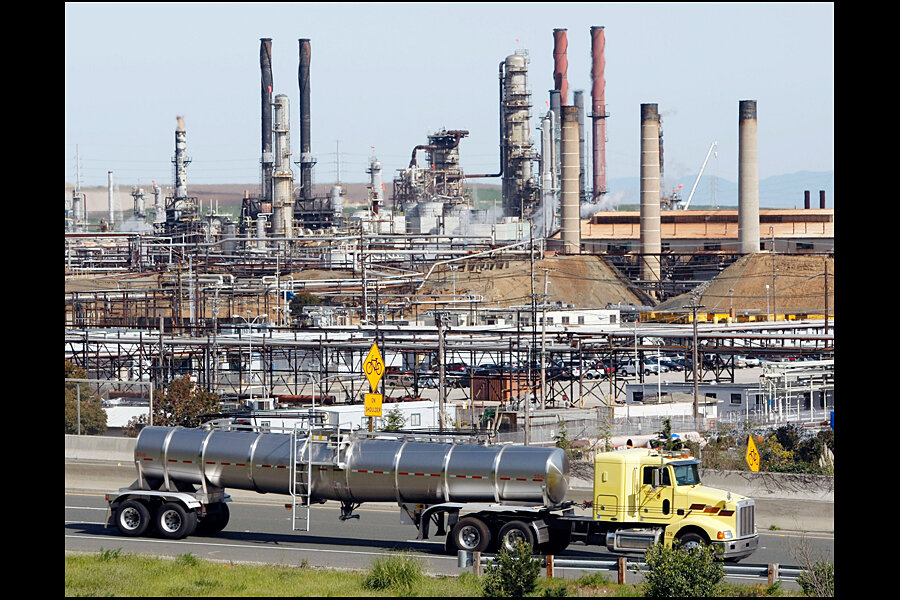EPA's new auto emissions regs 'a big deal,' industry says
Loading...
New clean air standards that will change the formula for American gasoline and the efficiency of the engines that burn it formally went into effect Monday.
The so-called “Tier 3” standards are part of the Obama administration’s broader push to rein in pollution and improve automobile fuel economy through federal agencies controlled by the president.
Tier 3 standards, together with the Environmental Protection Agency’s separate program to cut greenhouse gas emissions, are forecast to save thousands of lives annually, health officials said.
Environmentalists hailed the move as an “important step forward,” while petroleum industry groups said the standards will require refineries to make billions of dollars of upgrades for no significant benefit.
The Tier 3 standards require refineries to begin producing gasoline with less sulfur and other pollutants. At the same time, automakers will have to make engines that burn that cleaner fuel more efficiently. The new standards go into force in 2017, though smaller refineries will have up to seven more years to comply.
The separate greenhouse gas regulations are being implemented in the same time frame.
When the Tier 3 changes are fully implemented in 2025, they will slash fuel costs for consumers by $8,000 annually, the EPA said Monday.
Meanwhile, the new rules are also expected to cut tailpipe nitrogen oxides (NOx) emissions by 260,000 tons by 2018. With more than 50 million people live, work, or go to school near high-traffic roadways, total health-related benefits by 2030 are projected to be $7 billion to $19 billion annually, the EPA said.
"These standards are a win for public health, a win for our environment, and a win for our pocketbooks," said EPA Administrator Gina McCarthy in a statement.
In 2025, the new standards will have increased the average price of a vehicle by only $72, according to EPA estimates.
Automakers have gotten on board. They back the EPA's establishment of one set of emission standards for vehicles nationwide, replacing the patchwork of federal and state laws that existed previously.
That “is a big deal for us,” said Mike Robinson, vice president of sustainability and global regulatory affairs at General Motors, in a conference call Monday.
With the standards compelling refiners to produce new fuels for these cleaner-burning engines, there’s a recognition “that our cleaner cars will need cleaner fuels to fully achieve and optimize the improvements we are being asked to make,” said Mitch Bainwol, president of the Alliance of Automobile Manufacturers, in a statement.
But oil industry officials oppose the new rule, which will require refineries to further reduce sulfur and other fuel pollutants before they leave the facility.
“The massive refinery investments [Tier 3] would require could drive up the cost of making gasoline and weaken the nation’s energy security without producing much, if any, environmental benefit,” said Patrick Kelly, an American Petroleum Institute official, in a statement during the rulemaking process last year. “Most sulfur in gasoline has already been removed.”
The oil industry predicted last year that the standards could result in gas prices going up 6 to 9 cents per gallon. The EPA disputes that claim. Changes made during the rulemaking process allow the industry added time and flexibility to keep costs down, Ms. McCarthy said in the Monday conference call. It would cost less than a penny more per gallon to produce cleaner fuel that would vastly lower soot, smog, and toxic emissions from the new, more efficient engines, she said.
All together, Obama administration fuel economy and greenhouse gas standards covering model year vehicles from 2012-25 are projected to save American families more than $1.7 trillion in fuel costs, the EPA said.
Environmentalists applauded the White House for pressing ahead despite oil industry opposition.
“President Obama and Administrator McCarthy deserve great credit for this important step forward for clean air,” said Fred Krupp, president of the Environmental Defense Fund, in a statement.
The new measures, he noted, are supported by businesses, unions, public health groups, and states, as well as the auto industry.
“This broad coalition demonstrates, once again, that we can have a cleaner environment and a strong economy at the same time,” Mr. Krupp said.






